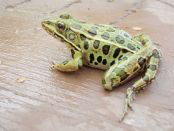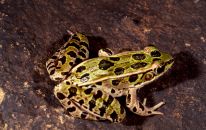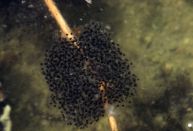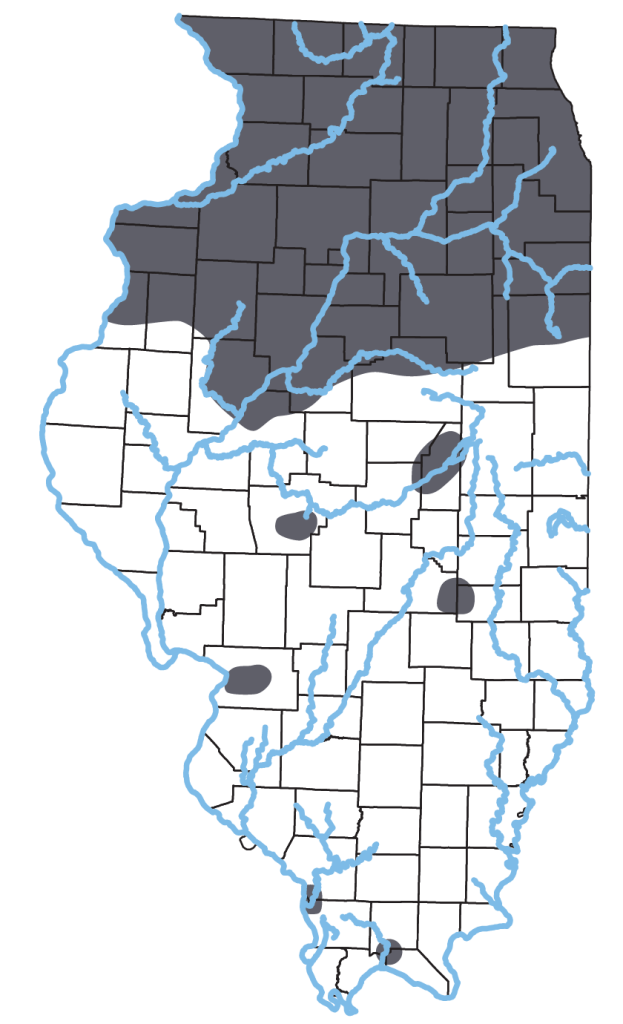Rana pipiens (Schreber, 1782)


Key Characters: Dark spots on back rounded, white margined, and mostly larger than eye; most individuals with dark spot on snout and unspotted tympanum.
Similar Species: Crawfish frog, Pickerel Frog, Plains Leopard Frog, Southern Leopard Frog. See Key to Frogs & Toads of Illinois for help with identification.
Subspecies: Prior to the recognition of species in the pipiens complex, two subspecies were recognized in Illinois; Northern Leopard Frog, Rana p. pipiens and Southern Leopard Frog, R. p. sphenocephala. The latter was elevated to full species.

Description: Medium-sized (5-9.6 cm SVL) green, tan, or brown frog with white belly and undersides of legs. Pale dorsolateral fold from each eye along back; often, additional but less prominent ridges between them. As in other leopard frogs and pickerel frogs, but not crawfish frogs, a light line runs along upper jaw. Vocal pouches at angles of jaws visible when male calls.
Habitat: Streams, ponds, lakes, wet prairies, and other bodies of water, frequently moving into grassy, herbaceous fields or forest borders some distance from permanent water.
Natural History: This strong jumper is difficult to capture during day. Emits startling “warning screams” when jumping into water and, when grabbed, may release urine to discourage potential predator and reduce weight for jumping. Eats a variety of invertebrates. Winter is spent under submerged logs or rocks in small streams or marshes where large numbers may congregate. Breeding call is described as long, deep rattling snore interspersed with clucking grunts. Eggs are laid during March–May and tadpoles transform late June to August.
Distribution Notes: Restricted to northern Illinois, north of a line approximately from Henderson to Iroquois counties. Redmer (1996. Locality records of the northern Leopard frog, Rana pipiens, in central and southwestern Illinois. Trans. Illinois Acad. Sci. 89:215-219) examined specimens from Sangamon and Madison counties, and found them to be pipiens by the presence of Mullerian ducts and the lack of external vocal sacks and discussed possible explanations for these records. I am currently working on the distribution map.
Status: Local abundance varies year to year. Widespread in northern third of state.
Etymology: Rana – rana (Greek) meaning frog; pipiens – pipio (Latin) meaning chirp, peep, twitter
Original Description: Schreber, H. 1782. Der Naturforscher. Johann Jacob Gebaur, Halle. 18:268 pp.
Type Specimen: UMMZ 71365 from Fall Creek, Etna, Thompkins County, New York, designated neotype by Pace (1974, Misc. Publ. Mus. Zool. Univ. Michigan. 148:16).
Type Locality: “Carolina”, “Neu Jersey”, “Neu York”.
Original Name: Rana pipiens Schreber, 1782
Nomenclatural History: The taxonomic history of the Northern Leopard Frog is quite complicated. For details, see Brown, Smith, and Funk (1977, Bull. Zool. Nomencl., 33: 195-203). Until 1973, at least, R. sphenocephala and R. blairi were not distinguished from R. pipiens, so many references to R. pipiens may, in fact, refer to any of these species. See Brown (1973. Speciation in the Rana pipiens complex. American Zoologist13:73-79) for details of recognition of species. Other names may have been applied to this species in the Illinois literature, but it is difficult to be certain if reference was to pipiens or one of the other leopard frogs when specific location information is lacking. Kennicott’s “Catalogue of Animals Observed in Cook County, Illinois” (Ill. State Ag. Soc. Trans. 1853-54 (1):577-595) listed Rana halecina Linnaeus, 1766. This is almost surely in reference to the Northern Leopard Frog, given the location. Davis & Rice also listed Rana halecina in their 1883 “List of Batrachia and Reptilia of Illinois” (Bulletin of the Chicago Academy of Sciences. vol. 1, no. 3). This is also a reference to L. pipiens as their work was concentrated in northern Illinois. Smith (1961) used the combination Rana pipiens pipiens.
Frost et al. (2006, Bull. Am. Mus. Nat. Hist., 297: 369) removed pipiens (and most other North, Central, and South American ranids) from Rana and placed it in Lithobates based on extensive DNA sequence data, but not all workers agree with this arrangement because of the instability this brings to well-known taxa such as Rana catesbeiana. AmphibiaWeb recommends using Rana (Lithobates) pipiens to demonstrate that it is a member of the subgenus Lithobates while preserving long-standing taxonomy.


